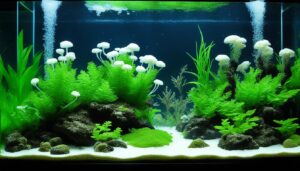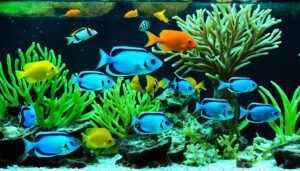As an aquarist, I always stress the need for preventing aquatic parasites to keep our fish healthy. Argulus, or fish lice, are a big threat to fish in both fresh and saltwater tanks worldwide. With over 100 species causing infestations, it’s crucial for fish lovers to watch out for these pests.
Species like Argulus foliaceus, A. japonicus, and A. coregoni often infect freshwater fish. These include goldfish, koi, and many cyprinids. Signs of infection, such as odd swimming, more mucus, and swelling, need quick attention to prevent worse health issues.
To fight these pests, we use a mix of treatments. This includes changing the environment and using chemicals like trichlorfon and emamectin benzoate carefully. Catching the problem early and acting fast is key to treating infected fish and stopping Argulus from spreading.
I believe in preventing fish lice more than curing them. That’s why I follow strict quarantine rules and keep the water clean. Knowing how Argulus live and what they like helps us keep our tanks free of them. Stopping an infestation early saves us from the trouble of dealing with a big parasite problem later.
The Fish Louse Explained
Understanding Argulus biology and how it impacts aquatic ecosystems is super important for keeping fish healthy. Argulus, or fish lice, are nasty branchiuran parasites that cause Argulus fish disease and can throw the whole aquatic balance out of whack.
The Biology of Argulus
The life cycle of Argulus is both fascinating and concerning because of the damage it can do to fish. It all kicks off with the female laying eggs on underwater surfaces. What’s scary is that these eggs can survive tough winters and hatch into larvae that need to find a host fast—or they won’t make it.
Once they latch onto a fish, they go through several molting stages, shedding their skin as they grow into adults. This molting process is critical for their development and fresh skin, but it’s bad news for the fish. Even after they reach adulthood, Argulus continue molting, and every stage harms the fish further. That’s why stopping them early is so important.
How Argulus Affect Aquatic Ecosystems
Argulus can wreak havoc in freshwater ecosystems. They latch onto all kinds of fish, causing physical damage and making the fish more susceptible to other diseases. This extra stress weakens the fish, which has a ripple effect on the entire ecosystem.
To make matters worse, Argulus can spread other diseases too, adding to the challenges for fish and water life. Understanding how they operate and taking action against them is crucial to protect aquatic environments.
Few Important Takeaways:
- The life cycle of Argulus directly influences how we manage them.
- Their molting process is essential for their growth and reproduction.
- Because of their high reproductive rate, effective control is a must.
By continuing to research and apply smart management strategies, we can limit the harmful effects of these parasites and help preserve the health of our aquatic ecosystems.
Identifying Argulus Infestation in Freshwater Fish
Species |
Infestation Increase During Outbreak |
Mortality |
|---|---|---|
Giant Gudgeon |
High |
2 Recorded Cases |
Sleepy Cod |
High |
3 Recorded Cases |
Grunters |
Moderate |
None Recorded |
My knowledge on dealing with Argulus comes from personal experience and research. It shows how important it is to watch over aquatic life. Knowing which fish are at risk and where these parasites are found helps us fight them better.
Treating and Managing Argulus Fish Louse Treatment
Dealing with Argulus, or fish lice, in fish tanks and farms is crucial. We need to look at both preventing and treating the problem. This includes removing fish lice by hand, treating the environment, and using chemicals. Let’s explore these methods and how well they work.
Manual Removal and Environmental Treatment
First, we can remove fish lice by hand. This means taking off the visible lice and their eggs from the fish and tank surfaces. In 2017, using plastic pipes to collect eggs helped reduce their numbers. Combining this with changing how fish are kept has shown to be effective in some studies.
Environmental treatments also help by changing the lice’s living space. For example, drying out tanks can get rid of eggs. But, this method needs careful planning and knowledge of the lice’s life cycle.
Chemical Interventions and Their Efficacy
When removing lice by hand and changing the environment isn’t enough, we use chemicals. Argulus chemical treatments include special pesticides. It’s important to pick these carefully because some fish may be sensitive to them. In the past, certain pesticides were used but now we use diflubenzuron and emamectin benzoate more often.
Treatment |
Efficacy |
Issues |
|---|---|---|
Organophosphate Pesticides |
High initially |
Resistance development |
Diflubenzuron |
Moderate to High |
Regulatory restrictions |
Emamectin Benzoate |
High |
Limited by lack of FDA approval |
Environmental Management |
Variable |
Dependent on location and climate |
How well these treatments work is key to keeping fish healthy and safe. Working with fish experts and following the law is important for a good plan to manage Argulus.
Effective Strategies for Preventing Argulus Infestations
Stopping Argulus infestations in fish farms and private ponds is key. We need to use many strategies to keep fish healthy and farms running well. Here, we look at ways to lower the risk of these pests.
Quarantine and Screening
Strong fish quarantine strategies are vital. Keeping new fish in quarantine for at least three weeks helps catch any parasites, like Argulus. This lets us check each fish for signs of infestation.
Keeping the quarantine area clean helps treat any new infections. This keeps the new fish safe and protects the ones already there.
Maintaining Water Quality for Prevention
Good water quality management is key to stopping Argulus. Keeping the water’s temperature, pH, and oxygen right makes it hard for fish lice to thrive. We should check and adjust these levels often to keep the water stable.
Checking and cleaning water filters, like UV ones, also helps. These systems remove parasites from the water. This keeps the fish safe and the water healthy.
Using careful screening and good water care together helps fight Argulus. This way, we can reduce the risks of fish lice and keep fish farms healthy and sustainable.
Recognizing the Risks: Secondary Infections and Pathogen Transmission
As a lover of marine life, I’ve learned that fish lice, or Argulus, are more than just a nuisance. They can cause Argulus secondary infections that harm fish health. These parasites damage fish tissue, letting harmful pathogens in. This can lead to serious health issues like swelling and tissue death, making aquatic health risks worse.
Studies show that Argulus can spread diseases, including spring viremia of carp. Environmental issues like pollution and toxins from events like red tide also stress marine life, making them more likely to get sick. The Gulf of Mexico is rich in life, but we know little about diseases in its fish due to the high cost of research.
This problem is clear in the Gulf of Mexico and other seas, where overfishing harms fish populations and increases bycatch. Keeping marine life healthy is crucial. Fighting Argulus is key to protecting our oceans. Early action helps stop parasites and diseases from spreading in our marine ecosystems.

